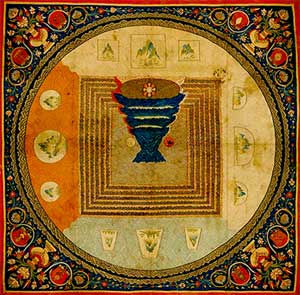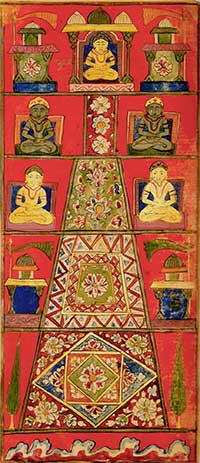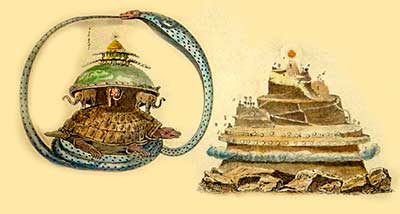
What is Mount Meru?

Mount Meru
The Christians believe that the earth was the center of the universe. Hindus believe that Mount Meru, a golden mountain, is the center of the universe. Mount Meru is the most sacred object in the universe because it supports the heavens and the gods. Geographically, it is said to exist at the center the universe in the waters of life, surrounded by seven concentric seas, each diminishing in size from the center. Jambudvipa, meaning the island of Jambu (role-apple) trees, rests in one of those oceans.
Technically, it is the entire landmass of the earth, surrounded by mountains. The island, Jambudvipa, is divided into four parts. That part of Jambudvipa, south of the Mount Meru, is called the land of the Bharatas (Bharatavarsha), which roughly corresponds to the Indian subcontinent, where people worship gods such as Brahma, Vishnu, Shiva, Indra, Agni and Soma. The gods reside in the heaven, on the top of the mountain, surrounded by sages, gods, celestial beings, heavenly damsels (apsaras) and the like.
 A symbolic depiction of Mount Meru
A symbolic depiction of Mount Meru
Mount Meru should not be mistaken as an ordinary mountain because it is so high that it reaches heaven and the pole star (dhruva) shine directly above it. The celestial river Ganges ( representing both life-energy and supreme consciousness) descents upon Mount Meru and flows in four different directions. Many stories are associated with the mountain.
In the Hindu Puranas, Meru is described as a deity himself. He is a friend of Vayu, the wind god, since both are located in the mid-region (antariksha). There is a story which suggests due to a conflict between Vayu and Meru, a portion of the mountain was blown off by Vayu and fell into the ocean forming the small island south of Bharatavarsha, now known as Sri Lanka.
According to the Devi-bhagavatam, on the east of Meru is located the city of Indra, named Devadhanicka, where the gods reside; on the south is the ciy of Yama, the lord of Death, named Samyamani; on the west is the great city of Varuna, named Nimnochani, where the sun sets; and on the north is the city of the Moon, named Vibhavari.
The sun goes around Meru and causes the worlds and beings to remain active. Each day he travels several thousands of yojanas at the speed of 14,200,000 yojanas per second (muhurt). Those who live upon the mountain always see the sun at the center. Earthly inhabitant see the sun rising in the east and setting in the west, but those who live on the mountain see the sun always and know that it never rests.By going around Meru and travelling through the four cities that exist on the four sides of Meru, the sun creates the illusion of time and becomes the manifester of time.
 Mount Meru and the Worlds
Mount Meru and the Worlds
Mount Meru is also mentioned in Buddhist and Jain texts. It forms part of the Buddhist universe and is depicted in the Buddhist Mandalas as the center of the universe. It is also referred to as Mount Sumeru. The Buddhist texts also mention its dimensions. It is said to be about 84,000 yojanas ( about 8500) miles in distance. Indra, the lord of the heavens lives on the top of the mountains while four heavenly kings reside on four sides of the mountain. Sumeru, as such is surrounded by seven concentric rings of mountains, each in turn separated from the next by seven perfume laden oceans.
Jambudvipa, the landmass, rests in the salt ocean, which is the outermost ocean. Jambudvipa is divided into four continent and surrounded by the outermost mountain range which stands on the edge of the world. The southern continent in Jambudvipa, is the birth place of the Buddha and it is where his doctrine is practiced. For the Buddhists, Mt.Sumeru is a sacred symbol, as it is the center of the universe. Equally sacred is Mount Kailas. According to Tibetan Buddhist beliefs, Demchok the wrathful Buddha (the equivalent of Shiva), resides upon this mountain.
Suggestions for Further Reading
- About Adityas, the 12 Suns or Solar Deities
- Agasthya the Hindu Sage who drank the oceans
- What is ahamkara or egoism?
- What is Ahimsa, Non-violence or Non-injury?
- Annam or Food in Hinduism
- Varnashrama Dharma, The Four Stages of Human Life
- The Concept of Avatar or Incarnation in Hinduism
- What is Citta or Chitta?
- Gods of Hinduism, the Eight Vasus
- The Vedangas: The Limbs of the Vedas
- The Concept of Atman or Eternal Soul in Hinduism
- The Problem of Maya Or Illusion and How To Deal With It
- Belief In Atman, The Eternal Soul Or The Inner Self
- Brahman, The Highest God Of Hinduism
- The Bhagavad Gita Original Translations
- The Bhagavadgita, Philosophy and Concepts
- Bhakti yoga or the Yoga of Devotion
- Hinduism And The Evolution of Life And Consciousness
- Why to Study the Bhagavadgita Parts 1 to 4
- Origin, Definition and Introduction to Hinduism
- Symbolic Significance of Numbers in Hinduism
- The Belief of Reincarnation of Soul in Hinduism
- The True Meaning Of Renunciation According To Hinduism
- The Symbolic Significance of Puja Or Worship In Hinduism
- Introduction to the Upanishads of Hinduism
- Origin, Principles, Practice and Types of Yoga
- Essays On Dharma
- Esoteric Mystic Hinduism
- Introduction to Hinduism
- Hindu Way of Life
- Essays On Karma
- Hindu Rites and Rituals
- The Origin of The Sanskrit Language
- Symbolism in Hinduism
- Essays on The Upanishads
- Concepts of Hinduism
- Essays on Atman
- Hindu Festivals
- Spiritual Practice
- Right Living
- Yoga of Sorrow
- Happiness
- Mental Health
- Concepts of Buddhism
- General Essays